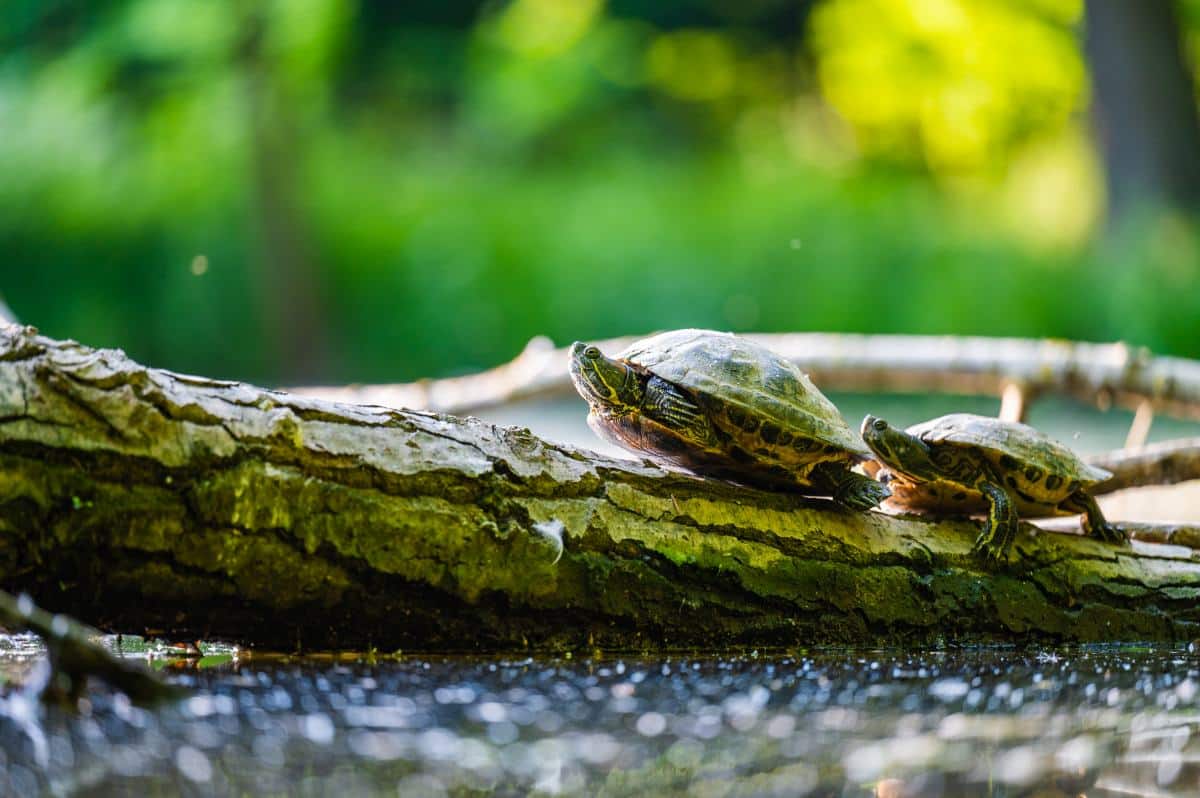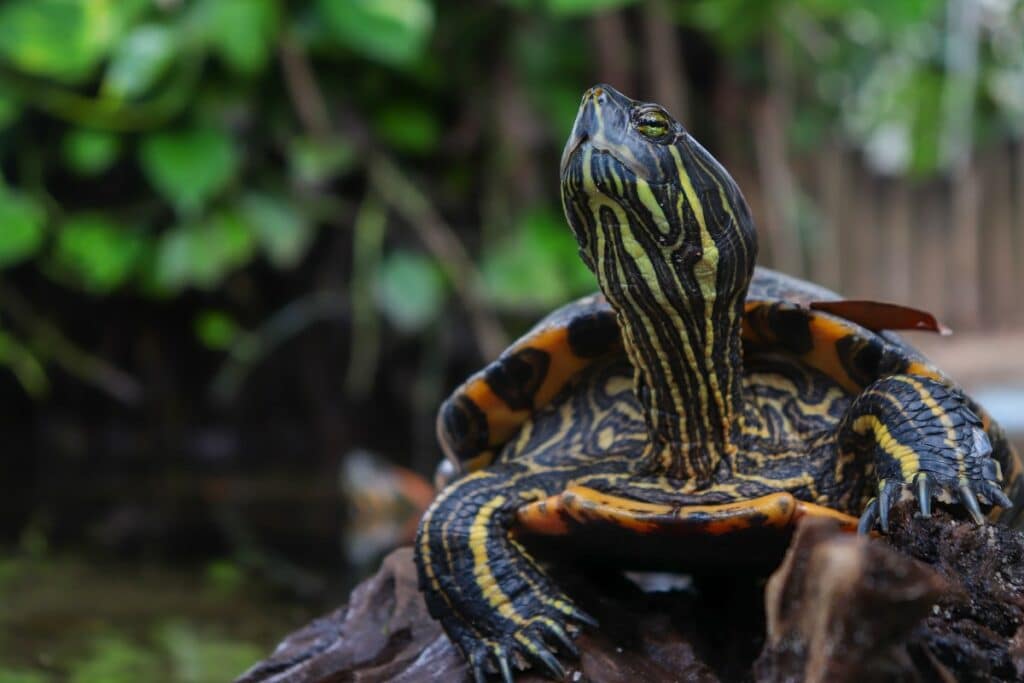the essentials in brief
In general, young animals cost around 20 to 100 euros. Keep in mind that in addition to the purchase price, there may be additional expenses for appropriate accessories and food.
Overwintering in a pond is not recommended. Here's how you should hold them instead...
Red-eared Slider turtles can live an impressive lifespan of up to 40 years or more. You can find more information about the turtle here...
Have you ever been to the fascinating underwater world of the Red-Eared Slider immersed? These extraordinary reptiles not only have a long, euphonious name, but also a history and characteristics that delight aquarium enthusiasts around the world.
In this blog post we take a closer look at the fascinating red-eared slider turtle and clarify what is important when it comes to keeping it.
The Red-eared Slider and its Characteristics

Have you ever heard of the red-eared slider? These fascinating reptiles are a popular choice for aquarium enthusiasts around the world. Its scientific name is Trachemys scripta elegans, but the common name is quite apt given its distinctive features.
When you look at a red-eared slider, you immediately become the conspicuous red markings on the sides of the head notice who gave it its name.
These bright red spots extend across the cheek region, giving this turtle species a distinctive look. The rest of the body is mostly in one rich green or brown held, which harmonizes perfectly with the red accents.
In terms of size, red-eared sliders tend to be compact. They are about the size of a coin when young, but over time they can up to 25 cm .
Life expectancy
Did you know that red-eared sliders can have exceptionally long lifespans? These fascinating reptiles can live up to 40 years or even longer. If you're considering keeping one of these turtles as a pet, be prepared to make a long-term commitment.
One of the most notable characteristics of this species of turtle is its adaptability. They feel comfortable in standing water such as ponds as well as in flowing water such as streams.
How to keep a red-eared slider
There are few creatures more fascinating than the red-eared slider. If you've decided to bring one of these wonderful reptiles into your life, it's important that you do too understand their needsto give them a happy and healthy home.
Creating the right home: Your red-eared slider turtle needs a spacious aquarium or pond as a home. Make sure you have enough space to swim and explore. A good guideline for the size of the aquarium is about 4 times the length of the turtle.
Temperature and lighting: Because red-eared sliders are cold-blooded, they need an external source of heat. Provide a UVB lamp to support vitamin D synthesis and keep the water temperature between 24 and 28 degrees Celsius.
A UBV lamp is available here:
Keep an eye on the water quality: Good water quality is essential. Use a powerful filter to keep the water clean and clear. The turtles will not only use the water for swimming, but also for drinking and eating.
Note: A good measure of water changes is every 1-2 weeks depending on the size of the aquarium, the number of turtles and the efficiency of the filter. A weekly partial water change of about 25-50% of the total water volume helps maintain water quality and remove contaminants.
Hiding possibilities and land part: In addition to water, these turtles also need a dry area of land where they can rest and sunbathe. Provide some rocks or a platform in the tank for them to bask on.
Social beings: Red-eared sliders are sociable animals and do well in company. It is advisable to keep several tortoises together, however they need adequate space to avoid aggression.
Caring for a red-eared slider requires commitment and attention, but the reward of seeing them grow up happy and healthy is second to none.
Proper nutrition of a red-eared slider
When it comes to the welfare of your red-eared slider, one is balanced nutrition of highest importance. These reptiles are omnivore, which means their meals should contain a diverse mix of plant and animal components to maintain their health and energy.
There are special turtle food, which is commercially available and provides a good base for your red-eared slider's diet. Make sure to choose a high-quality, well-balanced variety that contains important vitamins and minerals.
Supplement your tortoise's food with fresh vegetables such as lettuce, carrots, zucchini and cucumbers. These provide important fiber and nutrients. You can cut the pieces into small pieces to make them easier to chew.
Red-eared sliders also need it animal proteins. Occasionally offer them live food like insects, worms, or small fish. This protein supports their growth and energy.
Attention: Although fruit can be an additional source of nutrients, it should be fed in moderation as it often has a higher sugar content. Occasional feeding of fruits such as berries or pieces of apple is fine, but the amount should be monitored.
It is recommended yours Feed the turtle daily, especially when she is young. Adult tortoises can also be fed every two days. Be careful not to overfeed, as obesity can cause turtle health problems.
variety in the diet is crucial to ensure your red-eared slider is getting all the nutrients it needs. Experiment with different foods and see what your tortoise likes.

Red-Eared Slider: You have to watch out for this
The idea of having a red-eared slider as a new pet is exciting! Before you take that step, however, there are a few important things to consider to ensure you're welcoming your new furry friend provide the best home .
Before you start looking for a turtle, find out about theirs Needs, care requirements and life expectancy. This will help you be better prepared and fully understand the responsibility of your new pet.
Have you already prepared an aquarium or a pond? Remember that red-eared sliders need a lot of space. An aquarium with adequate swimming space and a dry land area is essential.
Buying turtles should always be done by reputable breeders or pet shops take place. Make sure the turtle is from a healthy environment to avoid disease.
The better you understand your future turtle, the better you can respond to their needs. Find out about her behavior, their food preferences and their habitsto form a close bond.
Additional information: Before you take the turtle home, have it checked by a veterinarian for any health issues. A thorough examination will ensure that you get a healthy animal.
Social needs of red-eared sliders
When you enter the enchanting world of the red-eared sliders, you will surely ask yourself whether these fascinating reptiles Society need.
The answer? A resounding yes! Red-eared sliders are sociable animals by nature social interactions enjoy. We explain why company is important to them and what kind of companions you can consider.
In the wild, red-eared slider turtles often live in groups or communities. This means they are used to living in the company of other turtles. These social interactions are important for their behavior, mental stimulation and well-being.
If you're thinking about adding more turtles to your household, that's a great idea! You can successfully red-eared sliders keep in a group.
Note: If you want to echo your turtles in groups, it's important to find the right balance. Make sure your aquarium is big enough to accommodate everyone. Young animals are often more compatible than older, more territorial individuals.
When you bring different turtles together, it's important to watch them to make sure no aggressive behavior appear. Watch for signs of aggression like biting or ongoing conflict.
In some cases it may be necessary to separate animals, if they cannot live together harmoniously.
Did you know that red-eared sliders are too in communities with other species of fish or aquatic turtles be able to live? However, you have to be extra careful, as not all animals are compatible. Fish should be large enough not to be considered prey, and aquatic turtles should require similar living conditions.
Discover the red-eared slider
In the world of exotics, the red-eared slider turtle has carved out a place all its own. From their conspicuous red markings to their social needs, this species of turtle offers one fascinating experience for aquarium enthusiasts.
Whether you're already an admirer of these wonderful creatures or considering adding one to your family, the red-eared slider offers a unique connection to the magical world of aquatic life.


